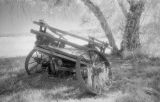
Influenced by the radio programme 100 Best Tunes John Bradshaw FRPS brought 100 interesting images to the club covering his over 30 years of photography. A member of Chichester Camera Club and the Arena and Focus groups of leading photographers, John talked about five different genres of photographs that were far from being "snaps".
His portraits began with two x-ray images and a MRI scan. He had been a consultant radiographer. A miner and ironworks worker followed, the latter wearing a tattered shirt shredded by sparks and molten hot metal. He honoured the 19th century photographer Julia Margaret Cameron with examples of some of her iconic images that he had emulated. These included Henry Wadsworth Longfellow and an allegory of suffering as part of his project on the Isle of White where Cameron had lived. Projects formed a major part of his work with The Slave Trade being another for which he had photographed an actor simulating being chained and suffering the torment of a long sea journey. Impressions of Irish History was another project, and his 'portrait' of Michael Collins' pistol was just one example. An image from Japan where a traditionally dressed lady spotted the photographer that her colleagues ignored provided some colour to a mainly monochrome collection.
Landscapes included Yosemite with echoes of Ansel Adams, Snowdonia, the Orkneys, Rannoch Moor, Kyoto, Marrakesh and Peacehaven, the latter comprising a fish eye lens image of white cliffs where the Greenwich Meridien leaves the UK for his series on the Meridien.
He had a camera converted to infra red and carefully illustrated how the chlorophyll in trees reflected the infra red light as part of his Infra red project. Gondolas in Venice similarly showed shadowy figures on the craft. The first electric lift in Brighton was another infra red image along with his most favourite image (illustrated) of a derelict farm cart in the grounds of an old Spanish mission in California, itself within a US Army base. Another fascinating image was of a former Georgian plantation with contrasting mansion and slaves' hut. This could also have figured in his 'Buildings' section that included the Chatterley Whitfield deep mine museum, a Lancashire cotton mill, where in former times children risked their lives dodging the machinery, a grotto church in Italy and a derelict house in the Orkneys. Mines also provided some 'Patterns' along with a skate park, high rise dual carriageways, a double-helix staircase and handrail in a swimming pool.
He finished with his twenty favourite images that illustrated all his various interests but also his interest in poetry to accompany his photographs. Especially poignant was an image of a grave marker from the 1845 potato blight in Ireland that took so many lives. It is accompanied by the following verse.
“She was sick with famine fever and could not keep up.
He lifted her and put her on his back.
He walked like that west and west and north.
Until at nightfall under freezing stars they arrived.
In the morning they were both found dead”.
This sparked a discussion about a possible future competition with illustrated poems and possibly a musically accompanied audio-visual.
